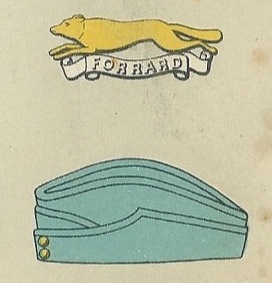 W
WThe Royal Tank Regiment (RTR) is the oldest tank unit in the world, being formed by the British Army in 1916 during the First World War. Today, it is the armoured regiment of the British Army's 12th Armoured Infantry Brigade. Formerly known as the Tank Corps and the Royal Tank Corps, it is part of the Royal Armoured Corps.
 W
WThe 1st Royal Tank Regiment was an armoured regiment of the British Army. It is part of the Royal Tank Regiment, itself part of the Royal Armoured Corps and operationally under 12th Armoured Infantry Brigade.
 W
WThe 2nd Royal Tank Regiment was an armoured regiment of the British Army. It was part of the Royal Tank Regiment, itself part of the Royal Armoured Corps and the 1st Mechanized Brigade.
 W
WThe 3rd Royal Tank Regiment was an armoured regiment of the British Army in existence from 1917 until 1992. It was part of the Royal Tank Regiment, itself part of the Royal Armoured Corps. It originally saw action as C Battalion, Tank Corps in 1917.
 W
WThe 40th Royal Tank Regiment was an armoured regiment of the British Army from 1938 until 1956. It was part of the Royal Tank Regiment, itself part of the Royal Armoured Corps.
 W
WThe 4th Royal Tank Regiment was an armoured regiment of the British Army from its creation in 1917, during World War I, until 1993. It was part of the Royal Tank Regiment, itself part of the Royal Armoured Corps.
 W
WThe 6th Royal Tank Regiment was a regiment of the Royal Tank Regiment, of the British Army, until 1959. It originally saw action as 6th Battalion Tank Corps in 1917.
 W
WThe 9th Royal Tank Regiment was an armoured regiment of the British Army active during the Second World War. It was part of the Royal Tank Regiment, itself part of the Royal Armoured Corps. It was reformed in late 1940 as a hostilities-only regiment.
 W
WThe 10th Royal Tank Regiment was an armoured regiment of the British Army during World War II. It was part of the Royal Tank Regiment, itself part of the Royal Armoured Corps. In February 1943, it was redesignated as 7th Royal Tank Regiment, replacing the previous 7th, which had been lost at Tobruk.
 W
WThe Westminster Dragoons (WDs) was a yeomanry regiment of the British Army Army Reserve, located in central London. Its lineage is continued by one of the Royal Yeomanry's six squadrons. Formed in the aftermath of Second Boer War as part of the County of London Yeomanry, the WDs fought in the Battle of Gallipoli and led British forces onto the beaches during the Normandy Invasion in 1944. The squadron most recently saw action on Operation Telic, for which it was mobilised for the 2003 war in Iraq.
 W
WThe Westminster Dragoons (WDs) was a yeomanry regiment of the British Army Army Reserve, located in central London. Its lineage is continued by one of the Royal Yeomanry's six squadrons. Formed in the aftermath of Second Boer War as part of the County of London Yeomanry, the WDs fought in the Battle of Gallipoli and led British forces onto the beaches during the Normandy Invasion in 1944. The squadron most recently saw action on Operation Telic, for which it was mobilised for the 2003 war in Iraq.
 W
WThe East Riding of Yorkshire Yeomanry was a unit of the British Army formed in 1902. Units of Yeomanry Cavalry were raised in the East Riding of Yorkshire in the 18th and early 19th centuries at times of national emergency: the Jacobite Rising of 1745, the French Revolutionary Wars and the Napoleonic Wars. These were stood down once each emergency was over. The East Riding of Yorkshire Yeomanry, was established in 1902, and this saw action during the First World War both in the mounted role and as machine gunners.
 W
WThe 42nd Royal Tank Regiment was an armoured regiment of the British Army from 1938 until 1956. It was part of the Royal Tank Regiment, itself part of the Royal Armoured Corps.
 W
WThe 44th Royal Tank Regiment was an armoured regiment of the British Army, which was part of the Royal Tank Regiment, itself part of the Royal Armoured Corps that saw active service in World War II.
 W
WThe 50th Royal Tank Regiment was an armoured regiment of the British Army's Royal Tank Regiment during the Second World War. It was part of the Royal Tank Regiment, itself part of the Royal Armoured Corps.
 W
WThe Band of the Royal Regiment of Fusiliers is an Army Reserve military band part of the 5th Battalion, Royal Regiment of Fusiliers.
 W
WThe Machine Gun Corps (MGC) was a corps of the British Army, formed in October 1915 in response to the need for more effective use of machine guns on the Western Front in the First World War. The Heavy Branch of the MGC was the first to use tanks in combat and was subsequently turned into the Tank Corps, later called the Royal Tank Regiment. The MGC remained in existence after the war until it was disbanded in 1922.
 W
WThe Malta Tanks was a unit designation for an independent Royal Tank Regiment (RTR) unit made of a mixture of British tank types deployed to Malta in World War 2.
 W
WThe Royal Tank Regiment Memorial is a sculpture by Vivien Mallock in Whitehall Court, London. It commemorates the Royal Tank Regiment.